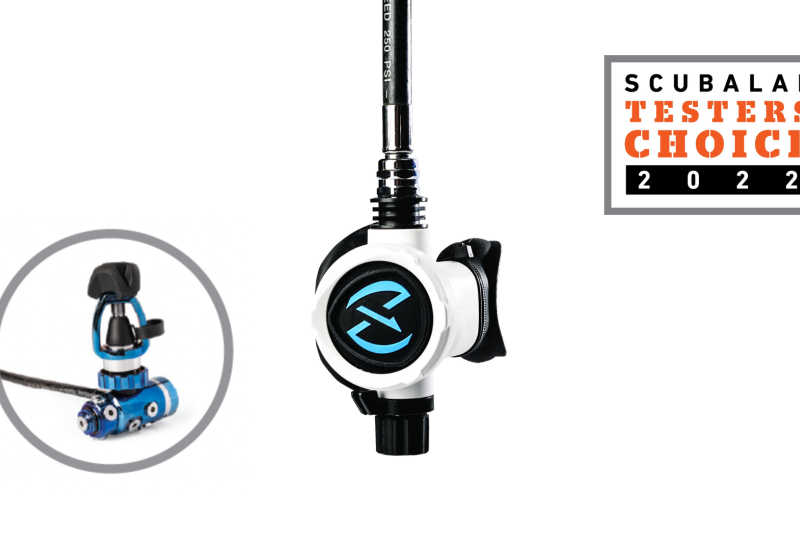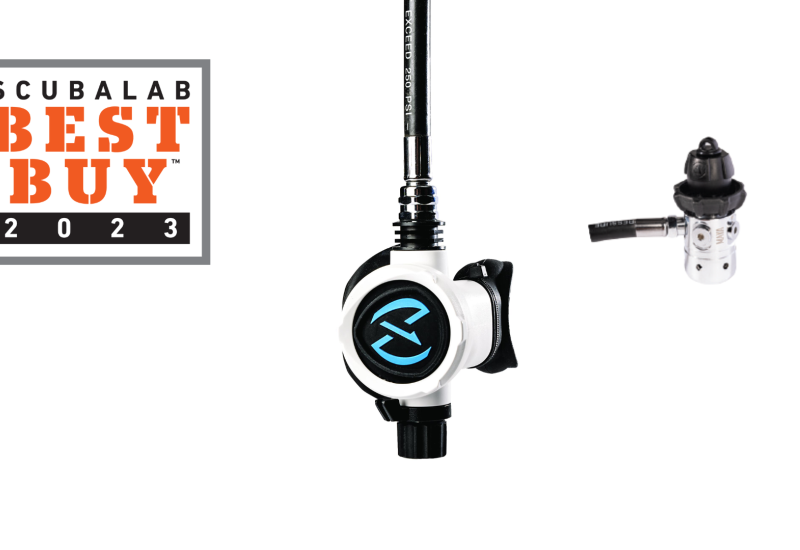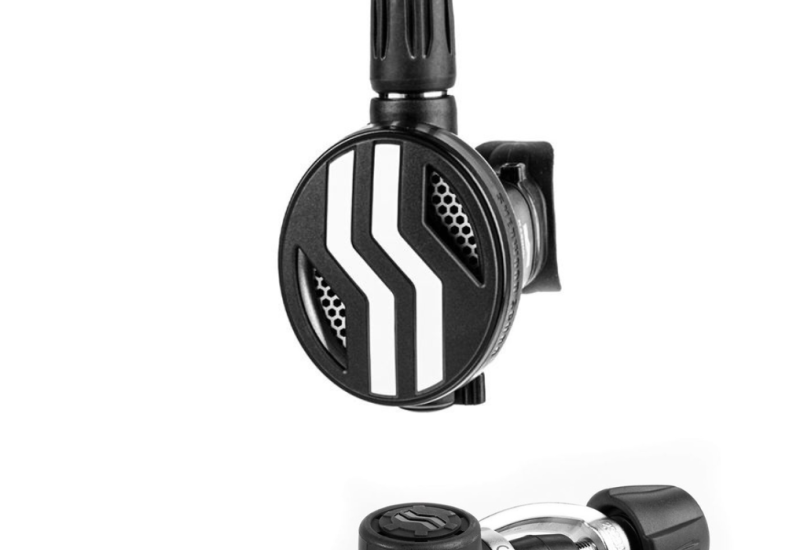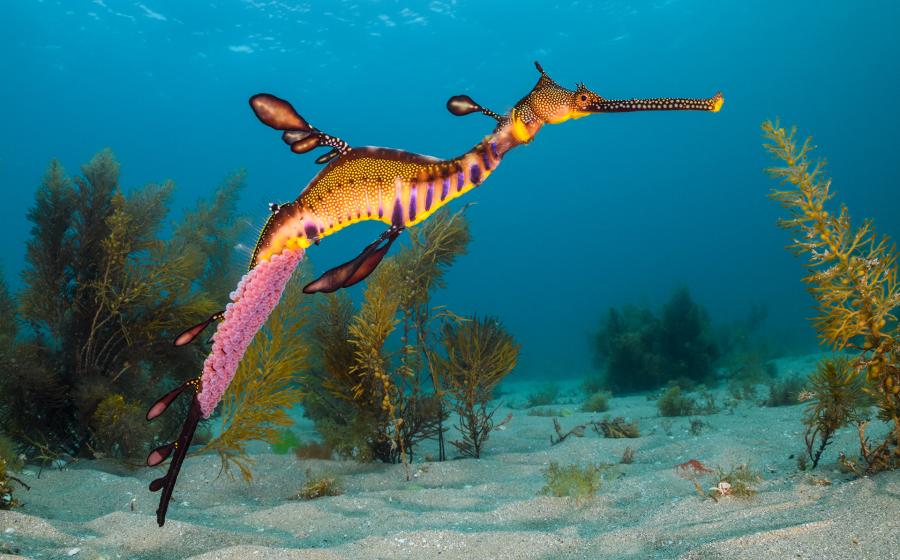17 Backup Breathers
 |
By John Brumm
Photography by Joseph Byrd
 |
You're cruising along at 60 feet, when suddenly your dive buddy pins you with silver-dollar eyes. Making a frenzied finger-slashing-the-neck signal, he starts power-kicking in your direction. Now, being a good guy, you want to help your buddy out, share your air, save his life, but is your backup breather up to the task?
If it's one of the 17 octopus regs in this review, then you and your careless buddy can both breathe easy. To evaluate the performance of backup regulators currently on the market, we invited all major manufacturers to send us their products for a demanding test similar to the one we use to scrutinize primary regulators. Any octopus reg that can perform well under these conditions (all did) should be up for the job it's designed for: Getting you or your buddy to the surface from 130 feet in an emergency.
The models we received fell into 3 categories:
Traditional-Style Octos are identical to primary regulators in size, function and breathing performance. These regs tend to be larger and therefore more difficult to stow easily, but they scored the highest for both ergonomics and air delivery. They're also familiar in design and operation, which can be comforting in an emergency air-sharing situation.
Detuned Traditional-Style Octos are also identical to primary regs, but these regs have been detuned slightly at the factory to prevent accidental free-flows. As a result, they may not score as well on the breathing simulator, but they can offer excellent performance without the need for adjustments.
Octo-specific regs are compact and low-profile models, which make them easy to stow when not in use. Their design and shape often make them better suited for use in an air-sharing situation, but these regs may not score as well in our tests.
Putting Them to the Test
After an initial inspection at the ScubaLab workshop, we took the regs and our team of six experienced test divers for three days of ocean diving off Catalina Island, Calif. Test divers rated each octo reg in eight specific ergonomic categories, ranging from the most important (ease of breathing and dryness) to moderately important (ease of purging, bubble interference and ease of deployment) to convenience items (comfort and adjustments).
In the final phase of testing, we used an industry standard ANSTI breathing simulator to measure the work of breathing of each reg at a variety of depths and breathing rates. To ensure a fair evaluation, all octos were connected to the same first stage, which was set at 139 psi, an intermediate pressure that not only falls in the middle of most manufacturer's recommendations (see: "Octo Basics," p. 61), but also represents the mid-range pressure setting of most first stages. In total, we captured approximately 190 data points, along with more than 75 pages of breathing loops, a graphic representation of a regulator's total inhalation and exhalation performance.
This data was translated into numeric scores and combined with ergo test results and test diver comments to come up with this year's best-performing backup breathers.
Traditional-Style Octos
Hand off one of these octos and you may be offering your buddy a backup regulator that is substantially better than the primary he's used to. Other than a longer hose, and yellow accents, there isn't anything that separates these octopus regs from their primary versions. Not surprisingly, they earned the highest scores on the breathing simulator and from test divers. Most have diver adjustments like breathing resistance knobs or a dive/pre-dive switch (some have both) that allow the user to prevent free-flows when not in use, but unlock peak breathing performance when needed.
ATOMIC AQUATICS: B2, Z2 & M1 Octos
||
|---|
|

|
SCUBA DIVING Testers' ChoiceSIMULATOR SCORES: 20 out of a possible 20.ERGO SCORES: 64 out of a possible 80 (B2), 62 out of a possible 80 (Z2, M1).
Like their primary second-stage counterparts, the octo versions of these pneumatically balanced regs feature Automatic Flow Control (AFC), which adjusts airflow to maintain a stable breathing effort regardless of depth. In fact, the only difference between an Atomic primary second stage and an Atomic octo is a longer hose (36 inches) and high-visibility yellow accents.
The B2 features an all-titanium valve body and comes standard with Atomic's Comfort Swivel. The Z2 uses a brass valve body that is plated with palladium/zirconium to resist corrosion, and its lever, orifice and second stage spring are titanium. The M1's valve body is also palladium/zirconium-plated brass with titanium components, plus it has a thermal heat sink for cold-water diving, a slightly wider exhaust tee and a purge cover designed to reduce free-flows when swimming into currents. All three octos are fitted with Atomic's dual-silicone mouthpieces.
As a group, these octos earned a top-of-the-pack position for perfect scores on the breathing simulator, and test divers told us they delivered dry, effortless breathing in all positions during ocean tests. They all generate minimal bubble interference and feature powerful purges. However, the B2 edged out its brethren in the ergonomic tests by virtue of its Comfort Swivel, which made handing off the reg easier. In fact, it was the only traditional-style octo to be rated Very Good for ease of deployment.
AQUA LUNG: Legend Octo
||
|---|
|

|
SCUBA DIVING Testers' ChoiceSIMULATOR SCORES: 20 out of a possible 20.ERGO SCORES: 62 out of a possible 80.
If you're a fan of Legend regulators, you're going to love the pneumatically balanced Legend Octo, because with the exception of a longer, high-vis yellow hose (39 inches) and a high-vis yellow full-cover purge and Vane Adjustment Switch (VAS), this is the same second stage. The Legend Octo proved to be a test diver favorite. A great breather in all positions, the octo is very dry, and because it has a wider exhaust tee than most octos, there is minimal bubble interference. The flexible, full-cover purge is easy to find and use, and the Venturi Adjustment Switch (VAS) is efficient in detuning the octo so it won't free-flow. The reg comes fitted with a heat exchanger for use in cold water and a standard-sized mouthpiece.
APEKS: XTX50, XTX40 & XTX20 Octos
||
|---|
|

|
SCUBA DIVING Testers' ChoiceSIMULATOR SCORES: 20 out of a possible 20.ERGO SCORES: 60 out of a possible 80.
Other than a longer yellow hose (36 inches) and yellow accents on the casing, Apeks's new pneumatically balanced XTX Series octos are mechanical twins of the XTX Series primary regs. That means they can be used with either left-hand or right-hand hose configuration. XTX octos come with a narrow exhaust tee installed for easier stowage and a more streamlined package. While there is an optional wide exhaust tee the user can install for maximum bubble dispersion, we tested them with the narrow tee.
The XTX50 Octo is Apeks's high-end model, offering both a ratcheting Reversible Venturi System (RVS) to prevent free-flows when not in use and a knob so you can dial in your preferred breathing resistance when using the octo. It is also fitted with a heat exchanger for cold-water diving. The mid-range XTX40 differs from the XTX50 only in that it has no breathing resistance knob and the RVS is nonratcheting. The low-end XTX20 differs from the XTX40 only in that it doesn't have a heat exchanger (it's designed for diving in water above 50 degrees Fahrenheit).
Test divers found all three octos to be smooth, efficient breathers in all positions. They also breathe dry, even when inverted. User adjustments are effective, and the center purge button is powerful, although some divers felt the button was a bit small for use on an octo reg.
AQUA LUNG: Calypso/Titan Octo
||
|---|
|

|
SIMULATOR SCORES: 20 out of a possible 20.ERGO SCORES: 59 out of a possible 80.
Although it just missed the cut for the Testers' Choice rating in this category, our evaluation clearly shows this simple, no-frills octopus version of Aqua Lung's Calypso second stage to be a worthy backup breather. It comes with a high-vis yellow 39-inch hose and a large yellow full-cover purge that delivers a powerful burst of air. This makes clearing the octo easy for an out-of-air diver on the verge of panic.
A Vane Adjustment Switch (VAS) helps prevent free-flows when the octo is not being used. Test divers found it to be a little small for a gloved hand and not very well-marked, but said it gets the job done. Its exhaust tee is larger than most, which contributes to better-than-average bubble dispersion, but also makes the reg a little harder to stow. All in all, however, the Calypso/Titan is a full-sized octo with full-sized breathing performance. It earned Very Good to Excellent scores on the breathing simulator, and test divers found it to be a smooth, dry breather.
Octo Basics
Remember that an octopus is really just a backup second stage regulator, so breathing characteristics may vary depending on the quality of the first stage it's hooked to. Most manufacturers recommend that their octo regs be teamed to one of their own first stages. If you decide to mix brands, make sure the octo you choose has an intermediate pressure range that matches that of your first stage. If it doesn't, you risk degraded breathing performance or unwanted free-flows. Bottom line, if you're not sure, it's probably best to have your dive store technician set up the rig for you.
Detuned Traditional-Style Octos
The regs in this category are also virtually identical to their primary versions, but in order to prevent free-flows when used as an octopus, they have been set at the factory with a slightly higher breathing resistance than normal. While a diver probably couldn't tell the difference in real-world use, the sensitive ANSTI machine can, and breathing machine scores for these regs may be slightly lower as a result.
SCUBAPRO: R295 Octo
||
|---|
|

|
SCUBA DIVING Testers' ChoiceSIMULATOR SCORES: 18 out of a possible 20.ERGO SCORES: 60 out of a possible 80.
Scubapro's R295 octopus is a simple non-adjustable reg that delivers solid performance. In our tests, it delivered Very Good to Excellent scores on the breathing machine and dry, comfortable breathing in real-world diving. It's nearly identical to the R295 primary second stage; however, the octo version is set at a higher cracking effort to prevent free-flows when not being used. The octo comes with a high-vis yellow hose protector, a 39-inch hose and a large yellow purge button. It can also be configured by a service tech with the low-pressure hose on either the left or right side of the casing. This lets you carry the octo on the left side of your rig, or simply provides a more comfortable breathing position for air sharing. The octo comes with its own stowage clip that includes a mouthpiece plug for keeping the orifice free of debris while at the same time helping to prevent free-flows.
MARES: Proton Metal Octo
||
|---|
|

|
SIMULATOR SCORES: 19 out of a possible 20.ERGO SCORES: 56 out of a possible 80.
Just like the primary version, the Proton Metal octo is a compact second stage made of nickel- and chrome-plated brass. Mares tunes the octo's cracking pressure about 10 percent higher than the primary second stage to prevent free-flows, and the octo comes with a 40-inch high-vis yellow hose and a mouthpiece plug that you can clip to your BC. This compact breather has no user adjustments, but it does offer Mares' Vortex Assisted Design (VAD), which incorporates a bypass tube into the body of the second stage to route air directly to the mouthpiece. This contributes to a lower breathing effort at depth.
In spite of a small second-stage housing, the octo's full-cover purge is extremely easy to use, even while wearing gloves, and the mesh grid minimizes free-flows in currents. The octo proved to be a very good breather, especially in the swimming position. On the breathing simulator it delivered Very Good to Excellent work of breathing.
CRESSI-SUB: Ellipse Octo
||
|---|
|

|
SIMULATOR SCORES: 14 out of a possible 20.ERGO SCORES: 58 out of a possible 80.
This octo makes use of an elliptically shaped second stage casing made of lightweight thermoplastic to cut down on jaw fatigue. In addition to a dive/pre-dive switch, it uses a different spring than the primary Ellipse second stage to help eliminate free-flows when the octo is not being used. It also uses a longer, 39-inch high-vis yellow hose to simplify air sharing and a yellow purge button to make it easy to see at depth.
Test divers told us that the elliptical shape of the second stage body makes for a compact package that's easy to stow. The dive/pre-dive switch is clearly marked and easier to use than most, but most found the purge button too stiff, making it difficult to clear the reg. On the plus side, test divers rated the Ellipse an efficient and dry breather in all positions and praised the comfortable mouthpiece.
Octo-Specific Style Regs
Purpose-built to serve only as a back-up breathers, these octopus regs are more streamlined, easier to stow and easier to deploy than traditional style regs. Although they tend to score lower on the breathing machine and in ergonomic evaluations than traditional-style regs, they offer enough performance to help out any air-starved buddy.
APEKS: Egress
||
|---|
|

|
SCUBA DIVING Testers' ChoiceSIMULATOR SCORES: 18 out of a possible 20.ERGO SCORES: 53 out of a possible 80.
The pneumatically balanced Egress is a low-profile breather that's designed to be stowed compactly when not needed, and easy to use when it comes time to share some air. The Apeks Egress (and Aqua Lung ABS) delivered the best performance on the breathing simulator in this category, and gave strong showings during ergonomic tests. It features a high-vis yellow 36-inch hose, a black casing with a yellow full-cover purge and a yellow exhaust grate. A 120-degree angle between the mouthpiece and the hose, and a puck-shaped casing that is designed to be used upside down or right-side-up, allows a panicky diver to easily grab this octo and immediately start breathing, regardless of position. This design also provides the option of carrying it on your left side.
The Egress has no user adjustments and no exhaust tee, but the bubbles vent away from the eyes. While test divers said the large purge button is a bit stiff, they rated this octo reg a good breather in all positions and very dry.
AQUA LUNG: ABS
||
|---|
|

|
SCUBA DIVING Testers' ChoiceSIMULATOR SCORES: 18 out of a possible 20.ERGO SCORES: 53 out of a possible 80.
The ABS is a more economical, unbalanced version of the Apeks Egress, yet, within the parameters of these tests, delivers virtually identical performance. It shares the same compact size and shape and can be used in either right-side-up or upside-down positions. It has no user adjustments, and bubbles exhaust out the side of the casing through a screened grating. The octo comes with 39-inch high-vis yellow hose. The case's purge cover retaining ring is also yellow, as is the exhaust screen grate, to help differentiate it from the primary second while at depth. The ABS is one of the few regs that comes with its own quick-release stowage clip that attaches to a BC's D-ring, allowing you to keep the octo tethered close to your body when not in use. The ABS has a more flexible purge cover than the Egress and comes with a standard-sized mouthpiece.
XS SCUBA: AirWave
||
|---|
|

|
SCUBA DIVING Testers' ChoiceSCUBA DIVING Best BuySIMULATOR SCORES: 15 out of a possible 20.ERGO SCORES: 55 out of a possible 80.
The AirWave connects its low-pressure hose on the left side of the casing so the octo can be directed to an out-of-air diver while minimizing radical hose bends. The mouthpiece comes out of the side of the casing, adjacent to, rather than on the opposite side of, the purge, creating a good angle for air sharing. It also creates a low profile for easy stowage. The AirWave doesn't have an exhaust tee, but bubbles vent out the side, relatively clear of your line of vision. The octo comes with a 36-inch hose, a high-vis yellow full-cover purge, and a dive/pre-dive switch.
The AirWave was a favorite among test divers, earning the highest total ergo score in this category. It's a good breather in all positions and very dry. The dive/pre-dive switch is not marked (you know it's in the "plus" position when the switch lever is in-line with the mouthpiece), but the purge is easy to use and very efficient. Above-average performance combined with a rock-bottom price make the AirWave a Best Buy. XS Scuba also offers a conversion kit that will turn the AirWave into an in-line octo that ties into your BC's inflator hose.
SHERWOOD SCUBA: Dual Octo
||
|---|
|

|
SIMULATOR SCORES: 16 out of a possible 20 (In-line), 17 out of a possible 20 (Std).ERGO SCORES: 51 out of a possible 80 (In-line), 48 out of a possible 80 (Std).
The new Dual Octo gives you a choice of two configurations, both of which can be used right- or left-handed, to match your individual rigging requirements and diving style. The standard configuration has the mouthpiece positioned at a 90-degree angle from the hose. The in-line configuration puts the mouthpiece in-line with the hose. Both styles are compact and present a low profile when clipped to a BC D-ring.
We tested the Dual Octo in both configurations. The standard configuration presents a good angle of attack when presented to an out-of-air diver, and the in-line configuration is even better. Breathing machine scores and test diver comments show that both configurations provide efficient breathing, although ergo scores showed the in-line version to breathe drier than the standard version when used in the diaphragm-up position.
ADVANCED DIVING PRODUCTS: Dynamo D.C. (Dual Configuration) Octo
||
|---|
|

|
SIMULATOR SCORES: 17 out of a possible 20 (In-line), 18 out of a possible 20 (Std).ERGO SCORES: 51 out of a possible 80 (In-line), 48 out of a possible 80 (Std).
The ADP Dynamo D.C. is nearly identical to the Sherwood Dual Octo. Differences include a more flexible, full-cover purge and a longer hose (39 inches). Performance-wise, the two brands, both in-line and standard versions, turned in identical results in ocean tests. In the more hair-splitting breathing machine tests, both versions of the ADP had a slight edge, work-of-breathing-wise, than their Sherwood counterparts.
XS SCUBA AltAir
||
|---|
|

|
SIMULATOR SCORES: 12 out of a possible 20.ERGO SCORES: 53 out of a possible 80.
-
Column A: 37.5 RMV @ 132 fsw: The maximum recreational depth at a somewhat aggressive breathing rate.
-
Column B: 62.5 RMV @ 165 fsw: The European conformance standard EN250. This is also the depth and breathing rate commonly used by manufacturers when determining a regulator's performance.
-
Column C: 62.5 RMV @ 198 fsw: The U.S. Navy's Class A test depth and breathing rate, but using a lower supply pressure.
-
Ease of breathing: How well the octo delivers air when the diver is propelling himself forward in the standard swimming position.
-
Different positions: How well the octo breathes in a head-down or face-up position.
-
Dives dry: How dry the octo breathes in normal swimming and odd positions.
-
Bubble interference: Considered while looking down, straight ahead, up at a 45-degree angle and straight up.
-
Ease of clearing: How difficult is it to find and use the purge? How dry is it after being cleared? How forceful is the purge? How much force is required to clear the octo by exhaling?
-
Ease of deployment: Is the octo designed with a shape or hose/casing attitude that makes it easy to insert in a buddy's mouth, and easy for the buddy to breathe off of it without kinking hoses or requiring special positioning between diver and buddy diver?
-
Comfort: Test divers rate the comfort of the mouthpiece, the feel of the second stage in the mouth, hose lengths and stiffness.
-
Adjustments: Are adjustments easy to find, grip and turn? Do they do their job in a reasonable manner?
The AltAir is the most compact, low-profile in-line style octo in this review. It also has a unique design feature: the male half of an X-Lock security clip is injection-molded into the AltAir's casing, which then attaches to the female half of the clip that comes on many modern BCs (if your BC doesn't have one, don't worry, the AltAir includes a female clip that you can attach to your BC). When not in use, the AltAir rides compactly and securely at your side. If you need it, all you have to do is give it a yank and the AltAir is ready for breathing. The octo comes with a 36-inch high-vis yellow hose, and a yellow full-cover purge.
The AltAir has dual exhaust valves but no exhaust tee, generating a fair amount of bubble interference. But the full-cover purge is powerful for easy clearing. The octo delivers good breathing in all positions, is very dry when used in the diaphragm-up position, and rates among the best for stowage.
Additional Findings
After three days of in-water testing and two days of breathing machine testing, ScubaLab staff and test divers came up with the following general observations on octopus regs.
SIZE MATTERS. For divers who feel breathing performance is all that counts, traditional-style octos are the way to go, in spite of the fact that they are bigger and bulkier and therefore harder to stow than octo-style breathers. However, other divers will gladly sacrifice a bit of breathing efficiency for a compact low-profile backup breather that stays out of the way when not needed.
PANICKY PURGING. Something to consider: Some divers felt that when it comes to a panicky diver groping for a breath of air, the larger the surface of the purge cover on an octo, the better.
DIAPHRAGM UP, DIAPHRAGM DOWN. Both machine and ergo tests showed that when breathing off an octo-specific in-line octo reg, or an octo reg with the mouthpiece positioned on the side of its casing where you have the option of breathing it either in an upside-down or right-side-up position, you will enjoy the lowest breathing resistance when breathing these models in a diaphragm-down position. The downside is, they will also breathe substantially wetter in this position. The exceptions to this are the Apeks Egress and Aqua Lung ABS, and to a lesser extent the XS Scuba AirWave.
{mospagebreak} Dive In
How (and Why) We Test Regulators
ScubaLab is the only consumer products testing organization that works for the sole benefit of recreational divers. The goal of our exclusive ScubaLab Reviews is to help you be an informed consumer of dive gear.
To fulfill this mission when testing regulators, including octopus regs, we use an industry-standard ANSTI wet breathing machine, which is capable of measuring minute differences in the inhalation and exhalation resistance at a variety of depths and breathing rates. Following internationally accepted test standards, a regulator's work of breathing (WOB) is measured in joules per liter for each complete inhale/exhale cycle, during which the highest inhale or exhalation pressure experienced by the "diver" should never exceed 25 millibars or a total WOB of 3 j/l.
If a reg exceeds either parameter, it "fails" our test, but that doesn't mean that it stops delivering air-only that the breathing resistance at some point in the cycle is higher than what is common for most modern regulators. All simulator tests are performed at a supply pressure of 725-760 psi. To ensure a level playing field, all octos are hooked to the same first stage, which is set at an intermediate pressure of 139 psi.
Breathing Rates and Depths
Regulators are tested at three different RMV/depth combinations (RMV stands for Respiratory Minute Volumes, basically the amount of gas that can be ventilated through the lungs in one minute). Here are the tests and what they represent:
Scoring the Results
A machine as accurate as the ANSTI simulator can accurately differentiate j/l measurements to tenths and even hundredths of a point. Human divers, however, can't detect differences much smaller than about .5 j/l. So for the sake of simplicity, we translate j/l measurements into scores on a 2 to 5 scale as follows:
5=Excellent: A total WOB of 1.05 j/l or less.
4=Very Good: A total WOB of 1.06 to 1.55 j/l.
3=Good: A total WOB from 1.56 to 2.25 j/l.
2=Fair: A total WOB of 2.26 to 3.0 j/l.
If a reg is unable to achieve the RMV/Depth category, its maximum depth within test parameters is recorded instead of a score.
Ergonomic Tests: The Human Factor
Breathing machines tell only half the story, however. To gauge the ergonomic traits of regulators, we use a minimum of six test divers. These divers represent a cross section of the sport and differ in age, dive experience, gender and diving interests. Each diver rates each reg for user-friendliness in eight areas, divided into three categories:
Most Important
Moderately Important
Convenience Items
Performance is recorded using both numeric scores on a 1 to 5 scale (5=Excellent, 4=Very Good, 3=Good, 2=Fair, 1=Poor) and written comments.
How We Pick Testers' Choice In this review, ScubaLab ratings-including Testers' Choice-are awarded within categories based on total scores for simulator and ergonomic tests.
Ergonomic scores are adjusted as follows: Actual scores x 3 for "Most Important" categories, actual scores x 2 for "Moderately Important" categories, and actual scores x 1 for "Convenience Elements" excluding user adjustment scores, as not all regs have adjustments. Simulator scores are adjusted x 2 only for Column A, the RMV/Depth test that best represents typical recreational diving (37.5 RMV @ 132 fsw).
|| |---|
|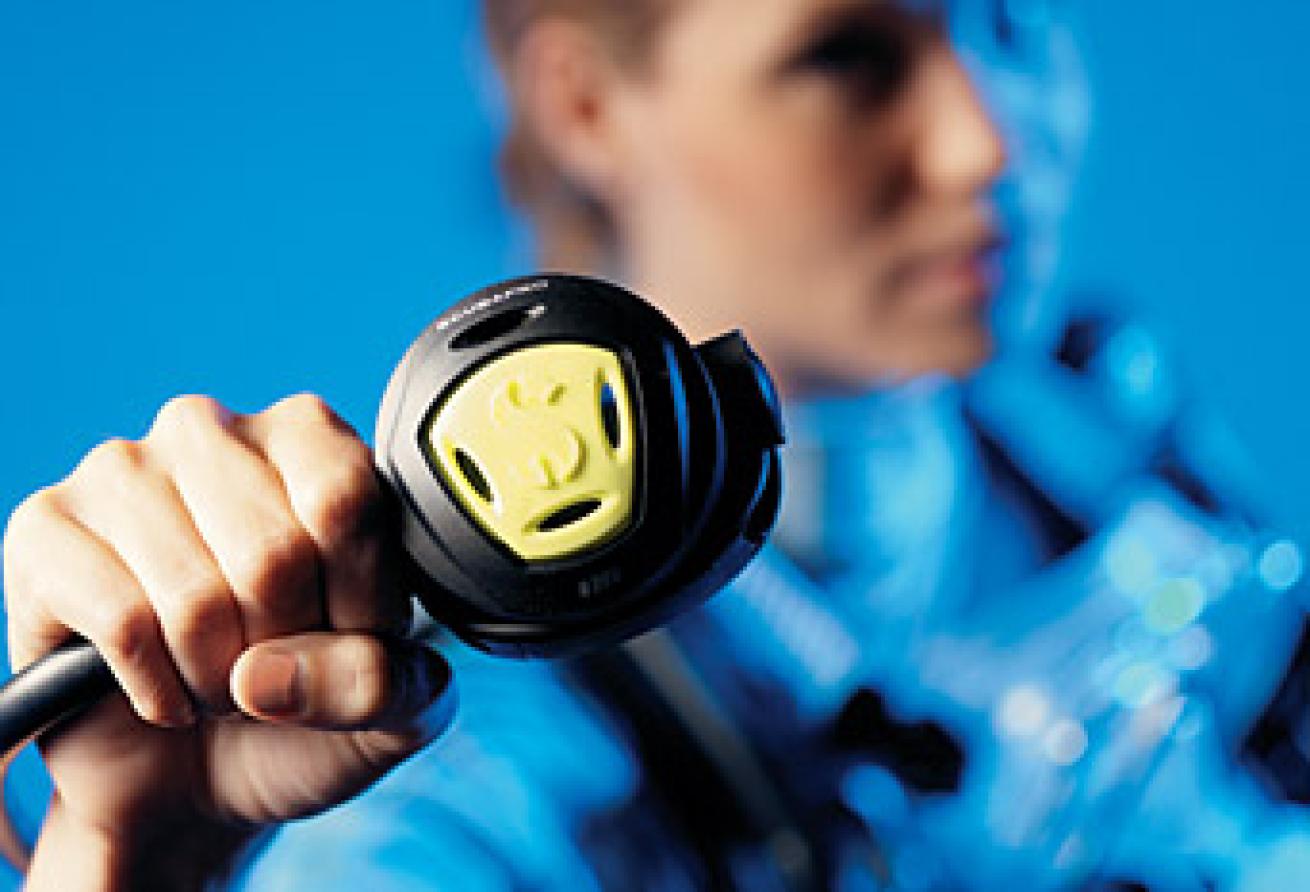
|
By John Brumm
Photography by Joseph Byrd
|| |---|
|
You're cruising along at 60 feet, when suddenly your dive buddy pins you with silver-dollar eyes. Making a frenzied finger-slashing-the-neck signal, he starts power-kicking in your direction. Now, being a good guy, you want to help your buddy out, share your air, save his life, but is your backup breather up to the task?
If it's one of the 17 octopus regs in this review, then you and your careless buddy can both breathe easy. To evaluate the performance of backup regulators currently on the market, we invited all major manufacturers to send us their products for a demanding test similar to the one we use to scrutinize primary regulators. Any octopus reg that can perform well under these conditions (all did) should be up for the job it's designed for: Getting you or your buddy to the surface from 130 feet in an emergency.
The models we received fell into 3 categories:
Traditional-Style Octos are identical to primary regulators in size, function and breathing performance. These regs tend to be larger and therefore more difficult to stow easily, but they scored the highest for both ergonomics and air delivery. They're also familiar in design and operation, which can be comforting in an emergency air-sharing situation.
Detuned Traditional-Style Octos are also identical to primary regs, but these regs have been detuned slightly at the factory to prevent accidental free-flows. As a result, they may not score as well on the breathing simulator, but they can offer excellent performance without the need for adjustments.
Octo-specific regs are compact and low-profile models, which make them easy to stow when not in use. Their design and shape often make them better suited for use in an air-sharing situation, but these regs may not score as well in our tests.
Putting Them to the Test
After an initial inspection at the ScubaLab workshop, we took the regs and our team of six experienced test divers for three days of ocean diving off Catalina Island, Calif. Test divers rated each octo reg in eight specific ergonomic categories, ranging from the most important (ease of breathing and dryness) to moderately important (ease of purging, bubble interference and ease of deployment) to convenience items (comfort and adjustments).
In the final phase of testing, we used an industry standard ANSTI breathing simulator to measure the work of breathing of each reg at a variety of depths and breathing rates. To ensure a fair evaluation, all octos were connected to the same first stage, which was set at 139 psi, an intermediate pressure that not only falls in the middle of most manufacturer's recommendations (see: "Octo Basics," p. 61), but also represents the mid-range pressure setting of most first stages. In total, we captured approximately 190 data points, along with more than 75 pages of breathing loops, a graphic representation of a regulator's total inhalation and exhalation performance.
This data was translated into numeric scores and combined with ergo test results and test diver comments to come up with this year's best-performing backup breathers.
Traditional-Style Octos
Hand off one of these octos and you may be offering your buddy a backup regulator that is substantially better than the primary he's used to. Other than a longer hose, and yellow accents, there isn't anything that separates these octopus regs from their primary versions. Not surprisingly, they earned the highest scores on the breathing simulator and from test divers. Most have diver adjustments like breathing resistance knobs or a dive/pre-dive switch (some have both) that allow the user to prevent free-flows when not in use, but unlock peak breathing performance when needed.
ATOMIC AQUATICS: B2, Z2 & M1 Octos
|| |---|
|
|
SIMULATOR SCORES: 20 out of a possible 20.
ERGO SCORES: 64 out of a possible 80 (B2), 62 out of a possible 80 (Z2, M1).
Like their primary second-stage counterparts, the octo versions of these pneumatically balanced regs feature Automatic Flow Control (AFC), which adjusts airflow to maintain a stable breathing effort regardless of depth. In fact, the only difference between an Atomic primary second stage and an Atomic octo is a longer hose (36 inches) and high-visibility yellow accents.
The B2 features an all-titanium valve body and comes standard with Atomic's Comfort Swivel. The Z2 uses a brass valve body that is plated with palladium/zirconium to resist corrosion, and its lever, orifice and second stage spring are titanium. The M1's valve body is also palladium/zirconium-plated brass with titanium components, plus it has a thermal heat sink for cold-water diving, a slightly wider exhaust tee and a purge cover designed to reduce free-flows when swimming into currents. All three octos are fitted with Atomic's dual-silicone mouthpieces.
As a group, these octos earned a top-of-the-pack position for perfect scores on the breathing simulator, and test divers told us they delivered dry, effortless breathing in all positions during ocean tests. They all generate minimal bubble interference and feature powerful purges. However, the B2 edged out its brethren in the ergonomic tests by virtue of its Comfort Swivel, which made handing off the reg easier. In fact, it was the only traditional-style octo to be rated Very Good for ease of deployment.
AQUA LUNG: Legend Octo
|| |---|
|
|
SIMULATOR SCORES: 20 out of a possible 20.
ERGO SCORES: 62 out of a possible 80.
If you're a fan of Legend regulators, you're going to love the pneumatically balanced Legend Octo, because with the exception of a longer, high-vis yellow hose (39 inches) and a high-vis yellow full-cover purge and Vane Adjustment Switch (VAS), this is the same second stage. The Legend Octo proved to be a test diver favorite. A great breather in all positions, the octo is very dry, and because it has a wider exhaust tee than most octos, there is minimal bubble interference. The flexible, full-cover purge is easy to find and use, and the Venturi Adjustment Switch (VAS) is efficient in detuning the octo so it won't free-flow. The reg comes fitted with a heat exchanger for use in cold water and a standard-sized mouthpiece.
APEKS: XTX50, XTX40 & XTX20 Octos
|| |---|
|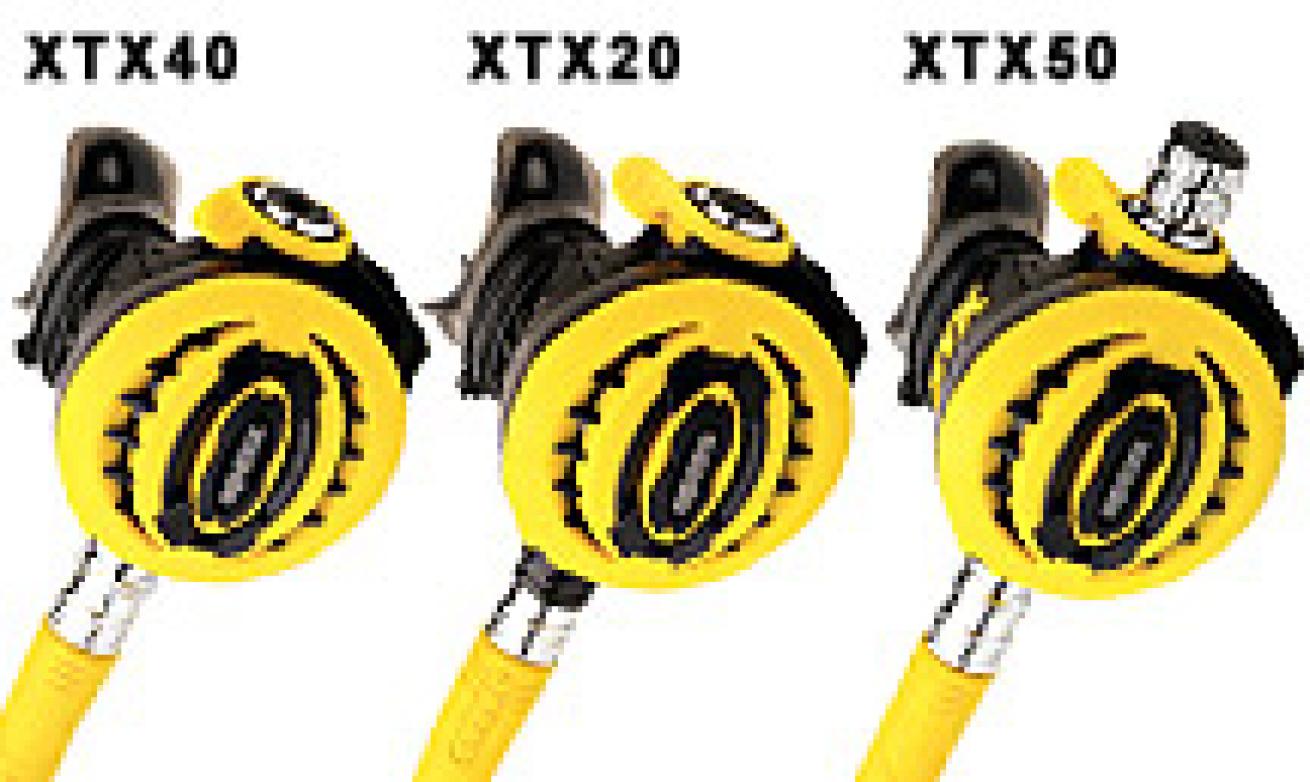
|
SIMULATOR SCORES: 20 out of a possible 20.
ERGO SCORES: 60 out of a possible 80.
Other than a longer yellow hose (36 inches) and yellow accents on the casing, Apeks's new pneumatically balanced XTX Series octos are mechanical twins of the XTX Series primary regs. That means they can be used with either left-hand or right-hand hose configuration. XTX octos come with a narrow exhaust tee installed for easier stowage and a more streamlined package. While there is an optional wide exhaust tee the user can install for maximum bubble dispersion, we tested them with the narrow tee.
The XTX50 Octo is Apeks's high-end model, offering both a ratcheting Reversible Venturi System (RVS) to prevent free-flows when not in use and a knob so you can dial in your preferred breathing resistance when using the octo. It is also fitted with a heat exchanger for cold-water diving. The mid-range XTX40 differs from the XTX50 only in that it has no breathing resistance knob and the RVS is nonratcheting. The low-end XTX20 differs from the XTX40 only in that it doesn't have a heat exchanger (it's designed for diving in water above 50 degrees Fahrenheit).
Test divers found all three octos to be smooth, efficient breathers in all positions. They also breathe dry, even when inverted. User adjustments are effective, and the center purge button is powerful, although some divers felt the button was a bit small for use on an octo reg.
AQUA LUNG: Calypso/Titan Octo
|| |---|
|
|
ERGO SCORES: 59 out of a possible 80.
Although it just missed the cut for the Testers' Choice rating in this category, our evaluation clearly shows this simple, no-frills octopus version of Aqua Lung's Calypso second stage to be a worthy backup breather. It comes with a high-vis yellow 39-inch hose and a large yellow full-cover purge that delivers a powerful burst of air. This makes clearing the octo easy for an out-of-air diver on the verge of panic.
A Vane Adjustment Switch (VAS) helps prevent free-flows when the octo is not being used. Test divers found it to be a little small for a gloved hand and not very well-marked, but said it gets the job done. Its exhaust tee is larger than most, which contributes to better-than-average bubble dispersion, but also makes the reg a little harder to stow. All in all, however, the Calypso/Titan is a full-sized octo with full-sized breathing performance. It earned Very Good to Excellent scores on the breathing simulator, and test divers found it to be a smooth, dry breather.
Octo Basics
Remember that an octopus is really just a backup second stage regulator, so breathing characteristics may vary depending on the quality of the first stage it's hooked to. Most manufacturers recommend that their octo regs be teamed to one of their own first stages. If you decide to mix brands, make sure the octo you choose has an intermediate pressure range that matches that of your first stage. If it doesn't, you risk degraded breathing performance or unwanted free-flows. Bottom line, if you're not sure, it's probably best to have your dive store technician set up the rig for you.
Detuned Traditional-Style Octos
The regs in this category are also virtually identical to their primary versions, but in order to prevent free-flows when used as an octopus, they have been set at the factory with a slightly higher breathing resistance than normal. While a diver probably couldn't tell the difference in real-world use, the sensitive ANSTI machine can, and breathing machine scores for these regs may be slightly lower as a result.
SCUBAPRO: R295 Octo
|| |---|
|
|
SIMULATOR SCORES: 18 out of a possible 20.
ERGO SCORES: 60 out of a possible 80.
Scubapro's R295 octopus is a simple non-adjustable reg that delivers solid performance. In our tests, it delivered Very Good to Excellent scores on the breathing machine and dry, comfortable breathing in real-world diving. It's nearly identical to the R295 primary second stage; however, the octo version is set at a higher cracking effort to prevent free-flows when not being used. The octo comes with a high-vis yellow hose protector, a 39-inch hose and a large yellow purge button. It can also be configured by a service tech with the low-pressure hose on either the left or right side of the casing. This lets you carry the octo on the left side of your rig, or simply provides a more comfortable breathing position for air sharing. The octo comes with its own stowage clip that includes a mouthpiece plug for keeping the orifice free of debris while at the same time helping to prevent free-flows.
MARES: Proton Metal Octo
|| |---|
|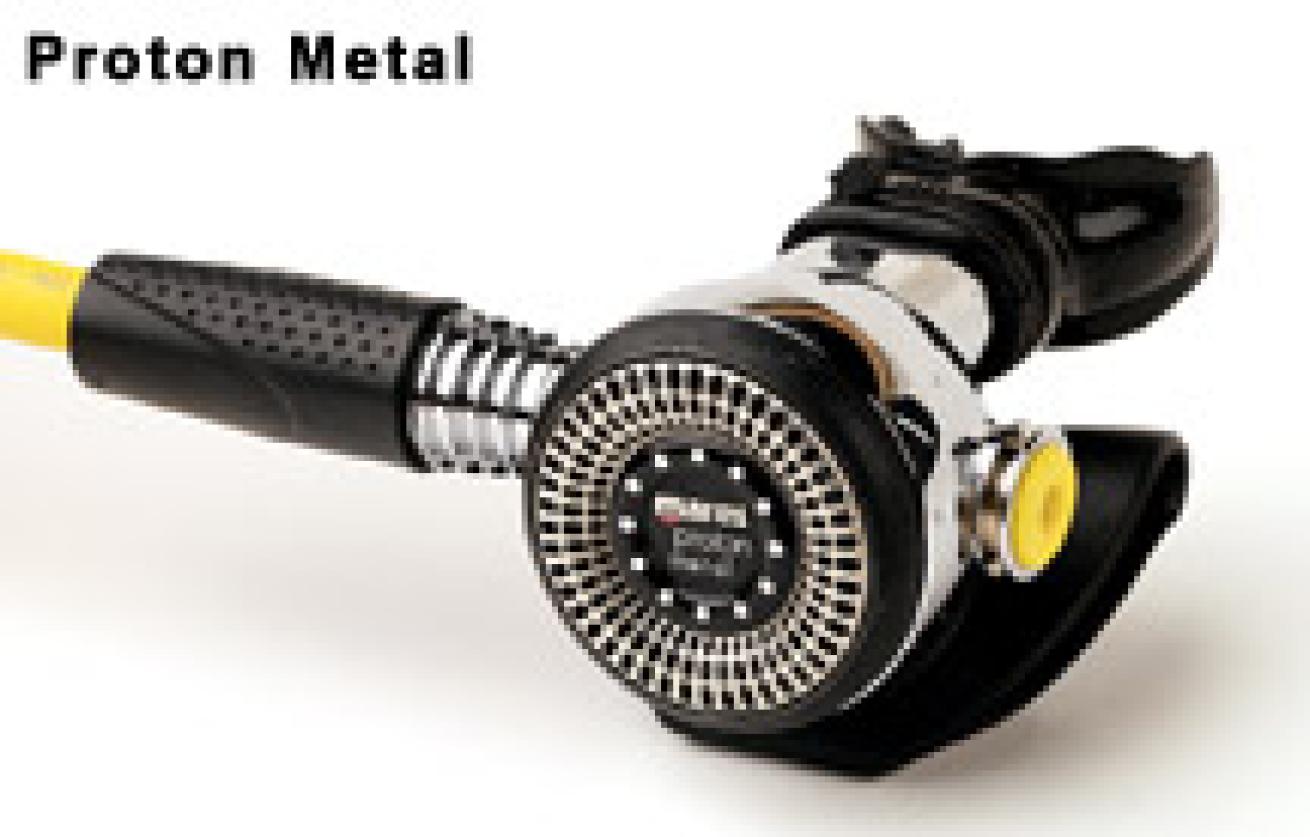
|
ERGO SCORES: 56 out of a possible 80.
Just like the primary version, the Proton Metal octo is a compact second stage made of nickel- and chrome-plated brass. Mares tunes the octo's cracking pressure about 10 percent higher than the primary second stage to prevent free-flows, and the octo comes with a 40-inch high-vis yellow hose and a mouthpiece plug that you can clip to your BC. This compact breather has no user adjustments, but it does offer Mares' Vortex Assisted Design (VAD), which incorporates a bypass tube into the body of the second stage to route air directly to the mouthpiece. This contributes to a lower breathing effort at depth.
In spite of a small second-stage housing, the octo's full-cover purge is extremely easy to use, even while wearing gloves, and the mesh grid minimizes free-flows in currents. The octo proved to be a very good breather, especially in the swimming position. On the breathing simulator it delivered Very Good to Excellent work of breathing.
CRESSI-SUB: Ellipse Octo
|| |---|
|
|
ERGO SCORES: 58 out of a possible 80.
This octo makes use of an elliptically shaped second stage casing made of lightweight thermoplastic to cut down on jaw fatigue. In addition to a dive/pre-dive switch, it uses a different spring than the primary Ellipse second stage to help eliminate free-flows when the octo is not being used. It also uses a longer, 39-inch high-vis yellow hose to simplify air sharing and a yellow purge button to make it easy to see at depth.
Test divers told us that the elliptical shape of the second stage body makes for a compact package that's easy to stow. The dive/pre-dive switch is clearly marked and easier to use than most, but most found the purge button too stiff, making it difficult to clear the reg. On the plus side, test divers rated the Ellipse an efficient and dry breather in all positions and praised the comfortable mouthpiece.
Octo-Specific Style Regs
Purpose-built to serve only as a back-up breathers, these octopus regs are more streamlined, easier to stow and easier to deploy than traditional style regs. Although they tend to score lower on the breathing machine and in ergonomic evaluations than traditional-style regs, they offer enough performance to help out any air-starved buddy.
APEKS: Egress
|| |---|
|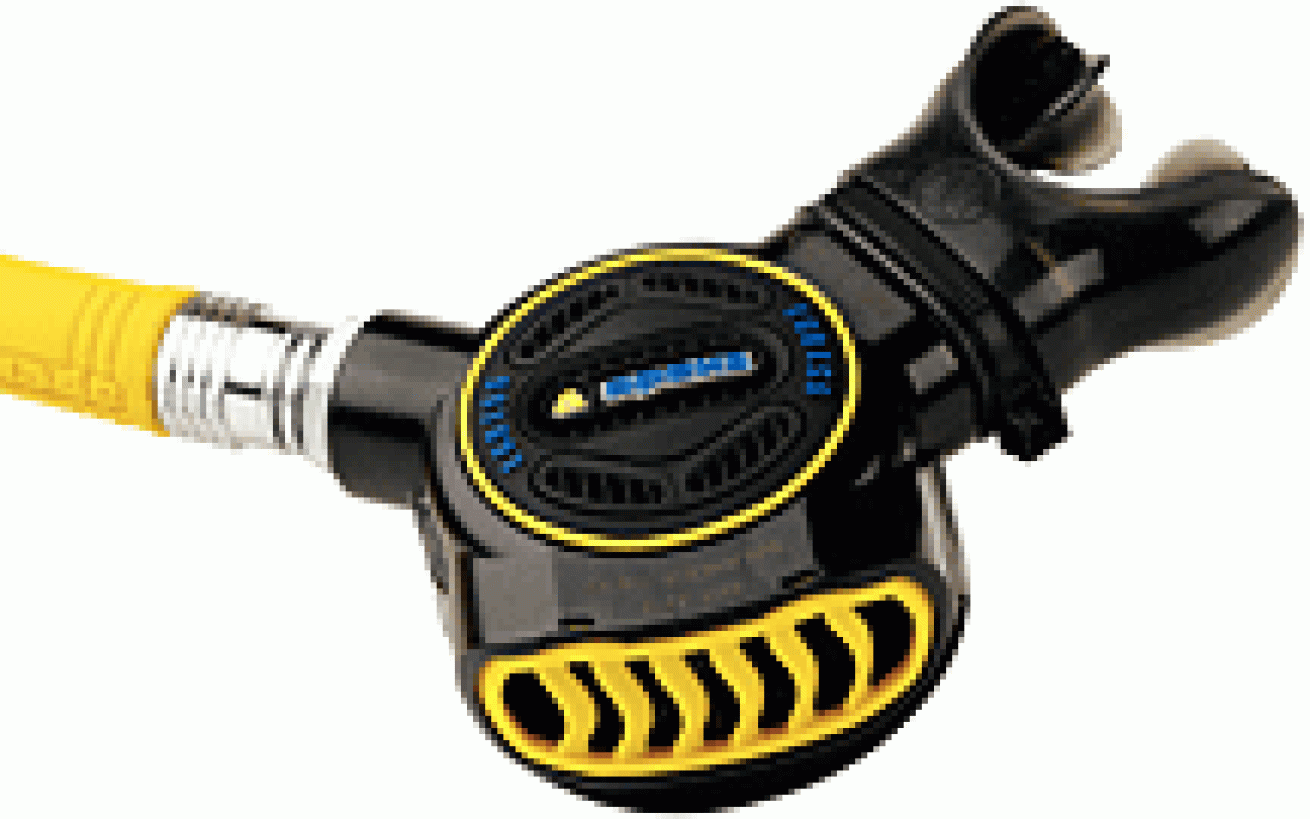
|
SIMULATOR SCORES: 18 out of a possible 20.
ERGO SCORES: 53 out of a possible 80.
The pneumatically balanced Egress is a low-profile breather that's designed to be stowed compactly when not needed, and easy to use when it comes time to share some air. The Apeks Egress (and Aqua Lung ABS) delivered the best performance on the breathing simulator in this category, and gave strong showings during ergonomic tests. It features a high-vis yellow 36-inch hose, a black casing with a yellow full-cover purge and a yellow exhaust grate. A 120-degree angle between the mouthpiece and the hose, and a puck-shaped casing that is designed to be used upside down or right-side-up, allows a panicky diver to easily grab this octo and immediately start breathing, regardless of position. This design also provides the option of carrying it on your left side.
The Egress has no user adjustments and no exhaust tee, but the bubbles vent away from the eyes. While test divers said the large purge button is a bit stiff, they rated this octo reg a good breather in all positions and very dry.
AQUA LUNG: ABS
|| |---|
|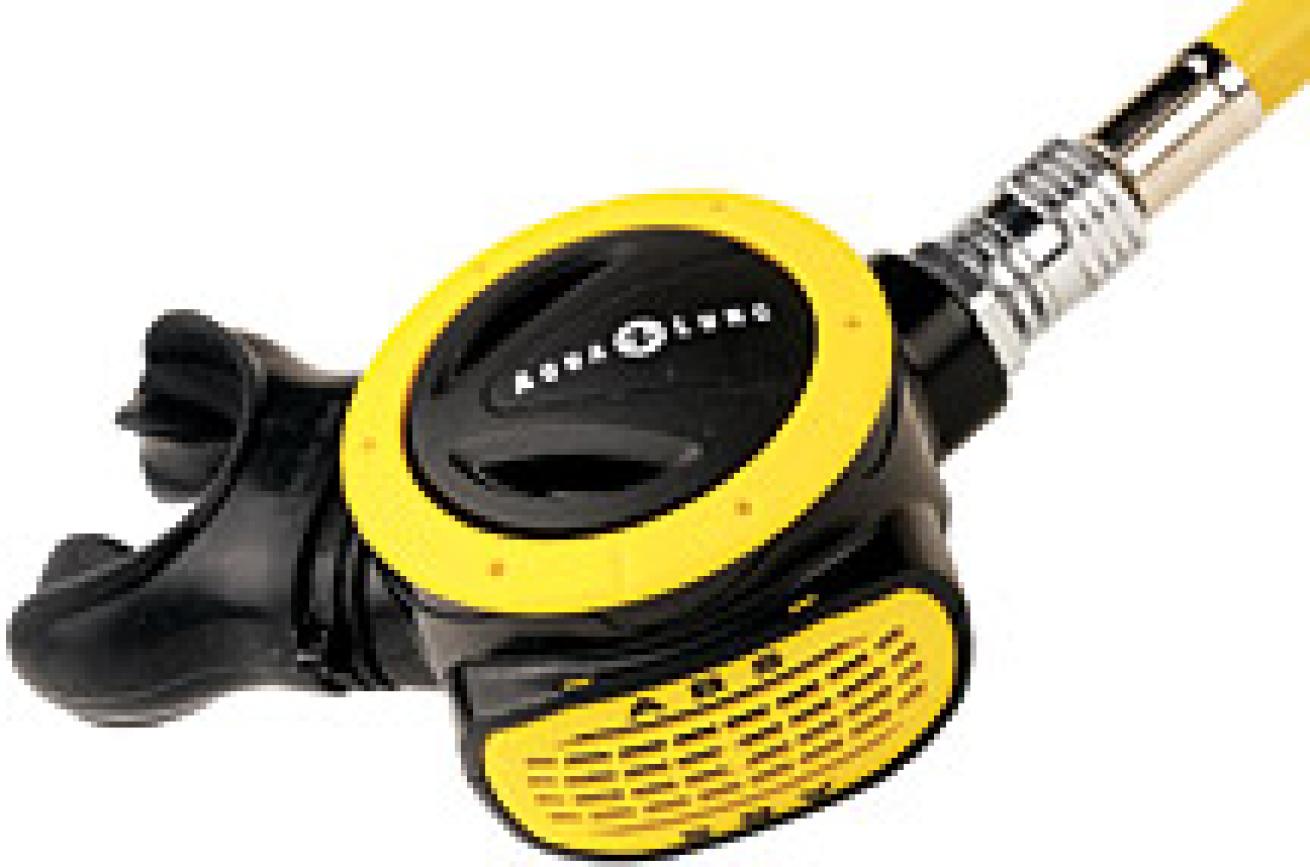
|
SIMULATOR SCORES: 18 out of a possible 20.
ERGO SCORES: 53 out of a possible 80.
The ABS is a more economical, unbalanced version of the Apeks Egress, yet, within the parameters of these tests, delivers virtually identical performance. It shares the same compact size and shape and can be used in either right-side-up or upside-down positions. It has no user adjustments, and bubbles exhaust out the side of the casing through a screened grating. The octo comes with 39-inch high-vis yellow hose. The case's purge cover retaining ring is also yellow, as is the exhaust screen grate, to help differentiate it from the primary second while at depth. The ABS is one of the few regs that comes with its own quick-release stowage clip that attaches to a BC's D-ring, allowing you to keep the octo tethered close to your body when not in use. The ABS has a more flexible purge cover than the Egress and comes with a standard-sized mouthpiece.
XS SCUBA: AirWave
|| |---|
|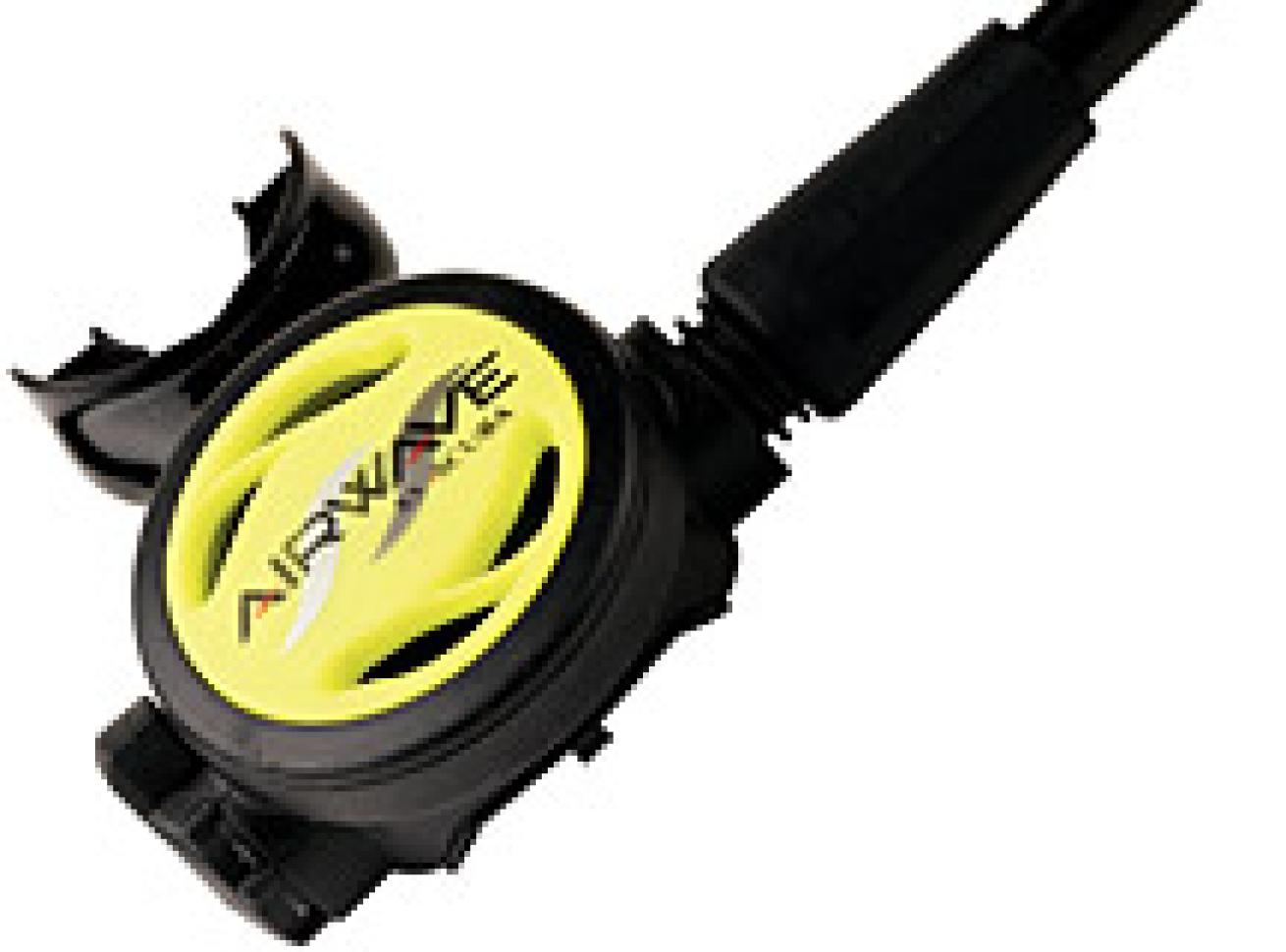
|
SCUBA DIVING Best Buy
SIMULATOR SCORES: 15 out of a possible 20.
ERGO SCORES: 55 out of a possible 80.
The AirWave connects its low-pressure hose on the left side of the casing so the octo can be directed to an out-of-air diver while minimizing radical hose bends. The mouthpiece comes out of the side of the casing, adjacent to, rather than on the opposite side of, the purge, creating a good angle for air sharing. It also creates a low profile for easy stowage. The AirWave doesn't have an exhaust tee, but bubbles vent out the side, relatively clear of your line of vision. The octo comes with a 36-inch hose, a high-vis yellow full-cover purge, and a dive/pre-dive switch.
The AirWave was a favorite among test divers, earning the highest total ergo score in this category. It's a good breather in all positions and very dry. The dive/pre-dive switch is not marked (you know it's in the "plus" position when the switch lever is in-line with the mouthpiece), but the purge is easy to use and very efficient. Above-average performance combined with a rock-bottom price make the AirWave a Best Buy. XS Scuba also offers a conversion kit that will turn the AirWave into an in-line octo that ties into your BC's inflator hose.
SHERWOOD SCUBA: Dual Octo
|| |---|
|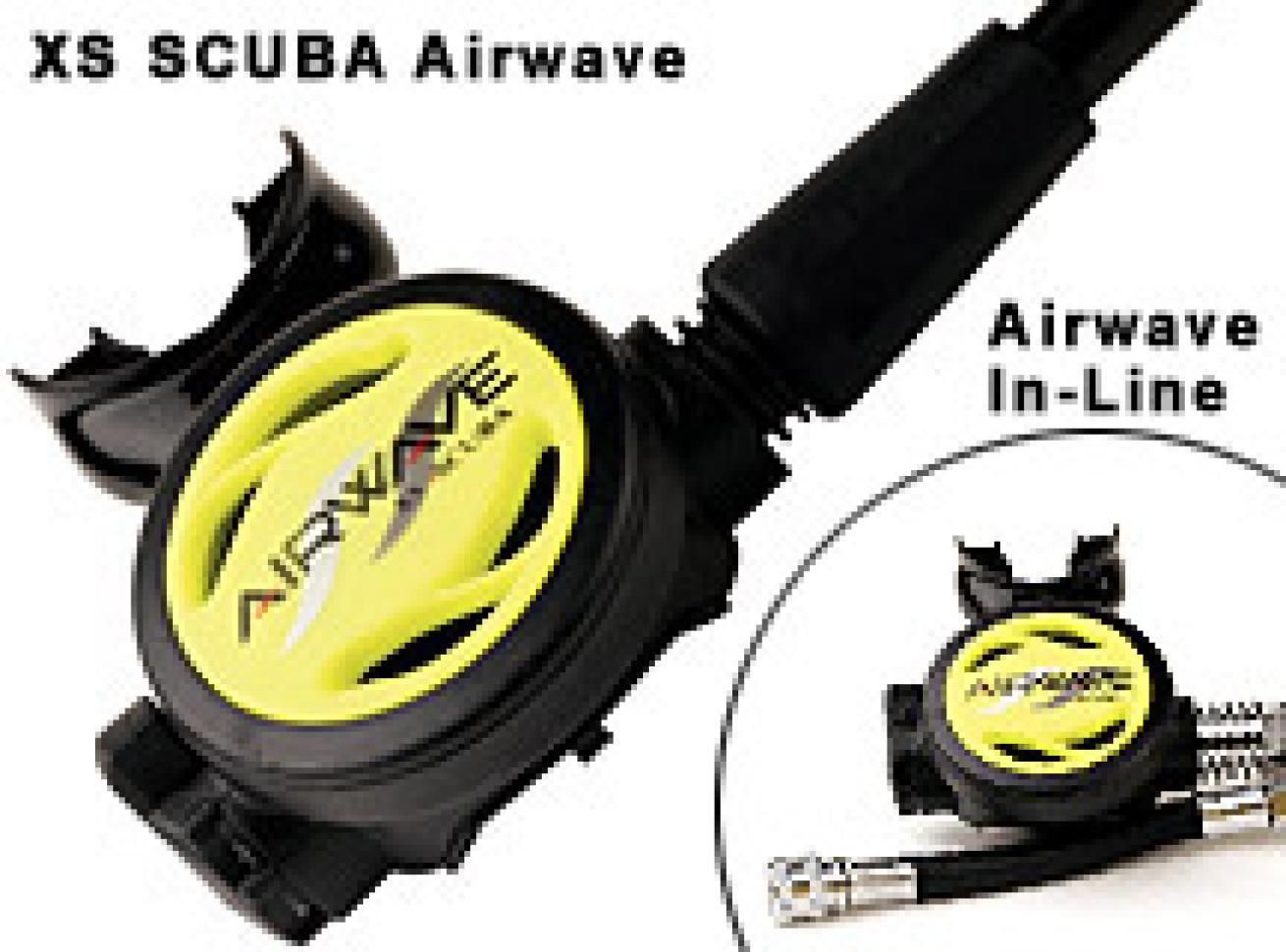
|
ERGO SCORES: 51 out of a possible 80 (In-line), 48 out of a possible 80 (Std).
The new Dual Octo gives you a choice of two configurations, both of which can be used right- or left-handed, to match your individual rigging requirements and diving style. The standard configuration has the mouthpiece positioned at a 90-degree angle from the hose. The in-line configuration puts the mouthpiece in-line with the hose. Both styles are compact and present a low profile when clipped to a BC D-ring.
We tested the Dual Octo in both configurations. The standard configuration presents a good angle of attack when presented to an out-of-air diver, and the in-line configuration is even better. Breathing machine scores and test diver comments show that both configurations provide efficient breathing, although ergo scores showed the in-line version to breathe drier than the standard version when used in the diaphragm-up position.
ADVANCED DIVING PRODUCTS: Dynamo D.C. (Dual Configuration) Octo
|| |---|
|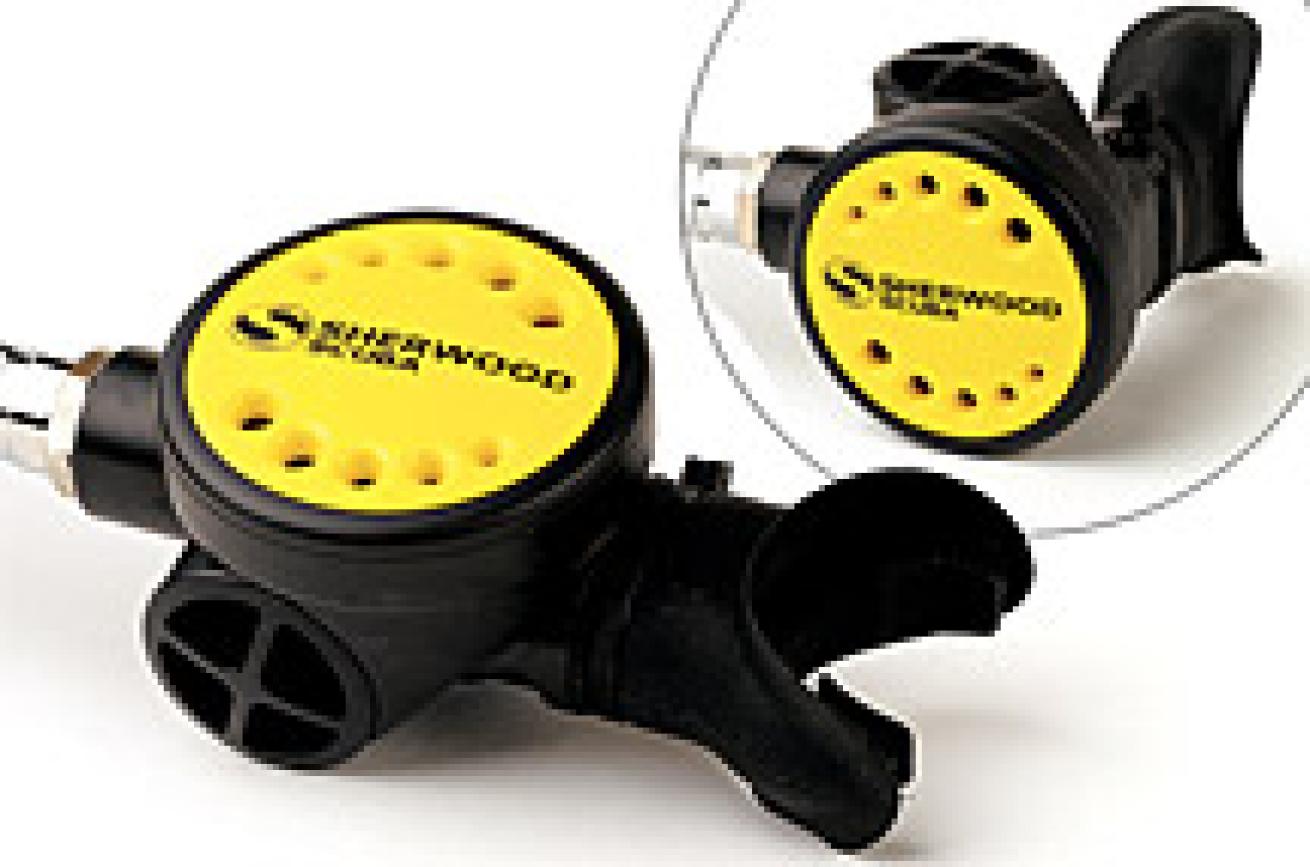
|
ERGO SCORES: 51 out of a possible 80 (In-line), 48 out of a possible 80 (Std).
The ADP Dynamo D.C. is nearly identical to the Sherwood Dual Octo. Differences include a more flexible, full-cover purge and a longer hose (39 inches). Performance-wise, the two brands, both in-line and standard versions, turned in identical results in ocean tests. In the more hair-splitting breathing machine tests, both versions of the ADP had a slight edge, work-of-breathing-wise, than their Sherwood counterparts.
XS SCUBA AltAir
|| |---|
|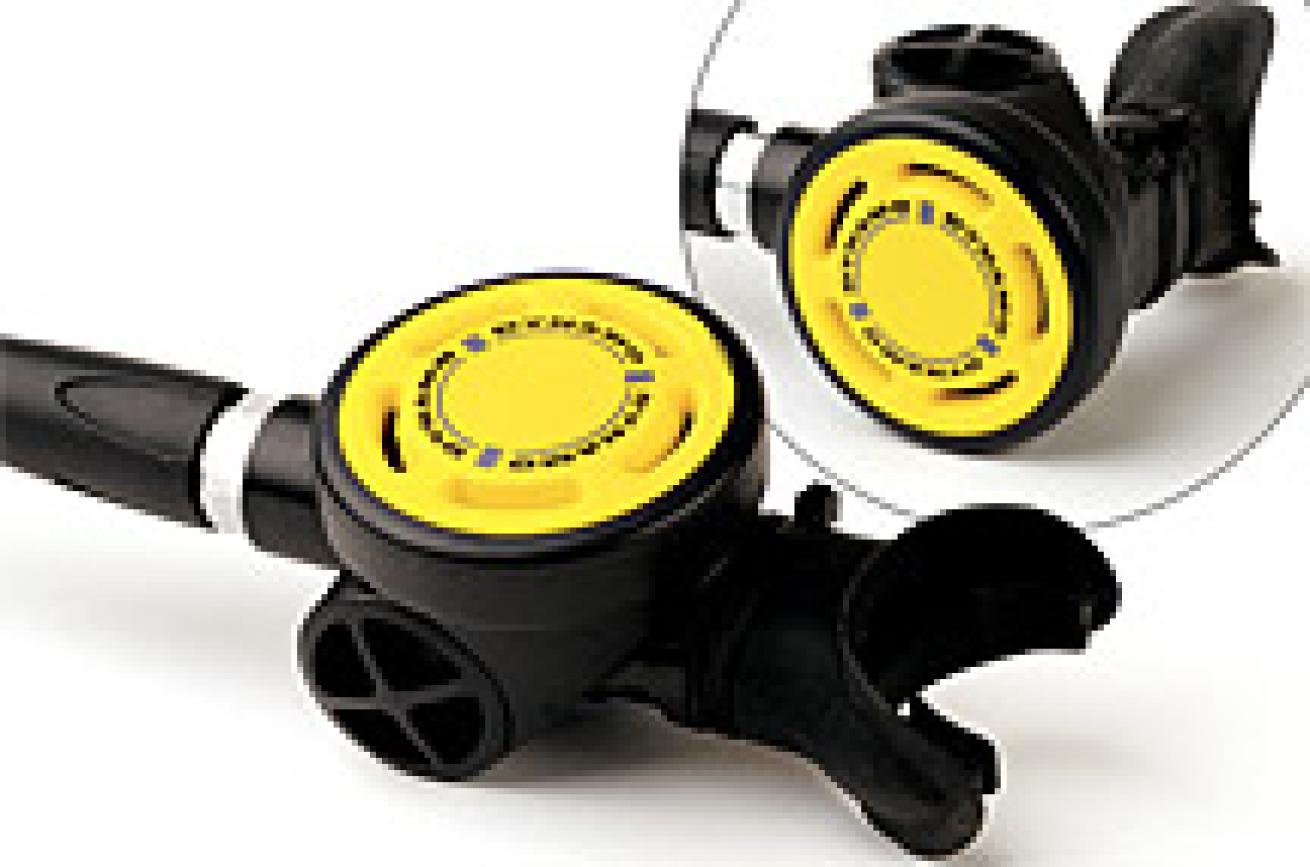
|
ERGO SCORES: 53 out of a possible 80.
The AltAir is the most compact, low-profile in-line style octo in this review. It also has a unique design feature: the male half of an X-Lock security clip is injection-molded into the AltAir's casing, which then attaches to the female half of the clip that comes on many modern BCs (if your BC doesn't have one, don't worry, the AltAir includes a female clip that you can attach to your BC). When not in use, the AltAir rides compactly and securely at your side. If you need it, all you have to do is give it a yank and the AltAir is ready for breathing. The octo comes with a 36-inch high-vis yellow hose, and a yellow full-cover purge.
The AltAir has dual exhaust valves but no exhaust tee, generating a fair amount of bubble interference. But the full-cover purge is powerful for easy clearing. The octo delivers good breathing in all positions, is very dry when used in the diaphragm-up position, and rates among the best for stowage.
Additional Findings
After three days of in-water testing and two days of breathing machine testing, ScubaLab staff and test divers came up with the following general observations on octopus regs.
SIZE MATTERS. For divers who feel breathing performance is all that counts, traditional-style octos are the way to go, in spite of the fact that they are bigger and bulkier and therefore harder to stow than octo-style breathers. However, other divers will gladly sacrifice a bit of breathing efficiency for a compact low-profile backup breather that stays out of the way when not needed.
PANICKY PURGING. Something to consider: Some divers felt that when it comes to a panicky diver groping for a breath of air, the larger the surface of the purge cover on an octo, the better.
DIAPHRAGM UP, DIAPHRAGM DOWN. Both machine and ergo tests showed that when breathing off an octo-specific in-line octo reg, or an octo reg with the mouthpiece positioned on the side of its casing where you have the option of breathing it either in an upside-down or right-side-up position, you will enjoy the lowest breathing resistance when breathing these models in a diaphragm-down position. The downside is, they will also breathe substantially wetter in this position. The exceptions to this are the Apeks Egress and Aqua Lung ABS, and to a lesser extent the XS Scuba AirWave.
{mospagebreak} Dive In
How (and Why) We Test Regulators
ScubaLab is the only consumer products testing organization that works for the sole benefit of recreational divers. The goal of our exclusive ScubaLab Reviews is to help you be an informed consumer of dive gear.
To fulfill this mission when testing regulators, including octopus regs, we use an industry-standard ANSTI wet breathing machine, which is capable of measuring minute differences in the inhalation and exhalation resistance at a variety of depths and breathing rates. Following internationally accepted test standards, a regulator's work of breathing (WOB) is measured in joules per liter for each complete inhale/exhale cycle, during which the highest inhale or exhalation pressure experienced by the "diver" should never exceed 25 millibars or a total WOB of 3 j/l.
If a reg exceeds either parameter, it "fails" our test, but that doesn't mean that it stops delivering air-only that the breathing resistance at some point in the cycle is higher than what is common for most modern regulators. All simulator tests are performed at a supply pressure of 725-760 psi. To ensure a level playing field, all octos are hooked to the same first stage, which is set at an intermediate pressure of 139 psi.
Breathing Rates and Depths
Regulators are tested at three different RMV/depth combinations (RMV stands for Respiratory Minute Volumes, basically the amount of gas that can be ventilated through the lungs in one minute). Here are the tests and what they represent:
Column A: 37.5 RMV @ 132 fsw: The maximum recreational depth at a somewhat aggressive breathing rate.
Column B: 62.5 RMV @ 165 fsw: The European conformance standard EN250. This is also the depth and breathing rate commonly used by manufacturers when determining a regulator's performance.
Column C: 62.5 RMV @ 198 fsw: The U.S. Navy's Class A test depth and breathing rate, but using a lower supply pressure.
Scoring the Results
A machine as accurate as the ANSTI simulator can accurately differentiate j/l measurements to tenths and even hundredths of a point. Human divers, however, can't detect differences much smaller than about .5 j/l. So for the sake of simplicity, we translate j/l measurements into scores on a 2 to 5 scale as follows:
5=Excellent: A total WOB of 1.05 j/l or less.
4=Very Good: A total WOB of 1.06 to 1.55 j/l.
3=Good: A total WOB from 1.56 to 2.25 j/l.
2=Fair: A total WOB of 2.26 to 3.0 j/l.
If a reg is unable to achieve the RMV/Depth category, its maximum depth within test parameters is recorded instead of a score.
Ergonomic Tests: The Human Factor
Breathing machines tell only half the story, however. To gauge the ergonomic traits of regulators, we use a minimum of six test divers. These divers represent a cross section of the sport and differ in age, dive experience, gender and diving interests. Each diver rates each reg for user-friendliness in eight areas, divided into three categories:
Most Important
Ease of breathing: How well the octo delivers air when the diver is propelling himself forward in the standard swimming position.
Different positions: How well the octo breathes in a head-down or face-up position.
Dives dry: How dry the octo breathes in normal swimming and odd positions.
Moderately Important
Bubble interference: Considered while looking down, straight ahead, up at a 45-degree angle and straight up.
Ease of clearing: How difficult is it to find and use the purge? How dry is it after being cleared? How forceful is the purge? How much force is required to clear the octo by exhaling?
Ease of deployment: Is the octo designed with a shape or hose/casing attitude that makes it easy to insert in a buddy's mouth, and easy for the buddy to breathe off of it without kinking hoses or requiring special positioning between diver and buddy diver?
Convenience Items
Comfort: Test divers rate the comfort of the mouthpiece, the feel of the second stage in the mouth, hose lengths and stiffness.
Adjustments: Are adjustments easy to find, grip and turn? Do they do their job in a reasonable manner?
Performance is recorded using both numeric scores on a 1 to 5 scale (5=Excellent, 4=Very Good, 3=Good, 2=Fair, 1=Poor) and written comments.
How We Pick Testers' Choice In this review, ScubaLab ratings-including Testers' Choice-are awarded within categories based on total scores for simulator and ergonomic tests.
Ergonomic scores are adjusted as follows: Actual scores x 3 for "Most Important" categories, actual scores x 2 for "Moderately Important" categories, and actual scores x 1 for "Convenience Elements" excluding user adjustment scores, as not all regs have adjustments. Simulator scores are adjusted x 2 only for Column A, the RMV/Depth test that best represents typical recreational diving (37.5 RMV @ 132 fsw).


